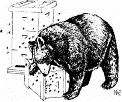Vertebrate Pest Conference Proceedings collection
Date of this Version
February 1982
Abstract
The development of exclusion fencing has been extensive in Australia in attempts to reduce losses of crops and livestock to rabbits (Oryctolagus cuniculus), dingos (Canis familiaris Var. dingo) and other species. Restrictions on other damage control methods have led to increased efforts in the United States to utilize such fences for protection of crops and livestock from dogs (Canis familiaris), coyotes (Canis latrans) and other species. Electric fences have occasionally been used to protect apiaries from black bears (Ursus americanus) and to protect some wildlife species from carnivores. Varied fence types include conventional net-wire or combinations of net and barbed wire, high voltage electric wires and conventional fences modified by addition of electric wires. Fences appear to be most useful and cost-effective on small open pastures with intensive production and appear to be least successful on large pastures with low production and high vegetative cover, which restricts removal of predators. Fences may be helpful in directing predator travel to areas where other control methods can be applied. Limitations on the use of exclusion fences include construction costs and the inability to exclude some predators or to remove them from fenced areas. Regulations related to protection of wild species such as pronghorn antelope (Antilocapra americana) may prohibit construction of effective exclusion fences, particularly on public lands. Difficulties and costs of fence maintenance are related to terrain, soil types, dense vegetation, fence damage by livestock and other animals, heavy snows, floodwaters and other causes. Predators gain access through damaged fences, malfunctioning electric fences, or by jumping over or digging under. Data indicate that where predators tend to be contained within such enclosures, fences may serve to increase losses to predation rather than to reduce them.

